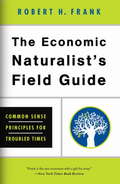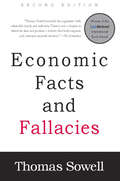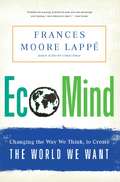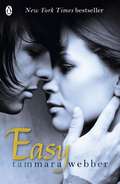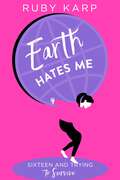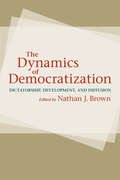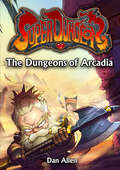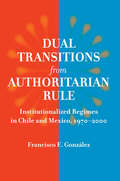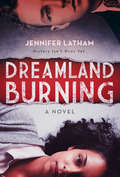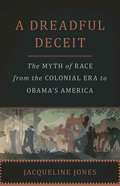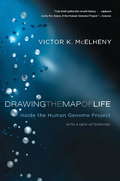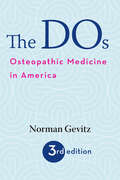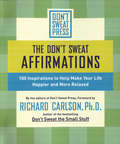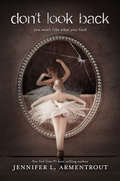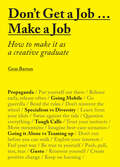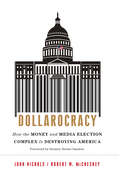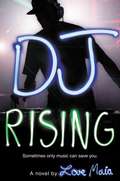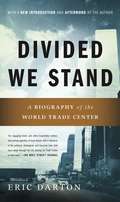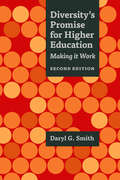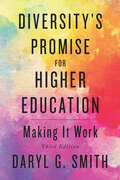- Table View
- List View
Economics: Theory Through Applications
by Russell Cooper A. Andrew JohnThis textbook, Economics: Theory Through Applications, centers around student needs and expectations through two premises: ... Students are motivated to study economics if they see that it relates to their own lives. ... Students learn best from an inductive approach, in which they are first confronted with a problem, and then led through the process of solving that problem. Many books claim to present economics in a way that is digestible for students; Russell and Andrew have truly created one from scratch. This textbook will assist you in increasing students' economic literacy both by developing their aptitude for economic thinking and by presenting key insights about economics that every educated individual should know.
The Economic Naturalist's Field Guide: Common Sense Principles for Troubled Times
by Robert H. FrankAsk a dozen talking heads about the course of action we should take to right the economy and you'll get thirteen different answers. But what if we possessed a handful of basic principles that could guide our decisions-both the personal ones about how to save and spend but also those national ones that have been capturing the headlines?Robert H. Frank has been illustrating these principles longer and more clearly than anyone else. In The Economic Naturalist's Field Guide, he reveals how they play out in Washington, on Wall Street, and in our own lives, covering everything from healthcare to tax policy to everyday decisions about what we do with our money. In today's uncertain economic climate, The Economic Naturalist's Field Guide's insights have more bearing than ever on our pocketbooks, policies, and personal happiness.
Economic Facts and Fallacies: Second Edition
by Thomas SowellEconomic Facts and Fallacies exposes some of the most popular fallacies about economic issues-and does so in a lively manner and without requiring any prior knowledge of economics by the reader. These include many beliefs widely disseminated in the media and by politicians, such as mistaken ideas about urban problems, income differences, male-female economic differences, as well as economics fallacies about academia, about race, and about Third World countries. One of the themes of Economic Facts and Fallacies is that fallacies are not simply crazy ideas but in fact have a certain plausibility that gives them their staying power-and makes careful examination of their flaws both necessary and important, as well as sometimes humorous. Written in the easy-to-follow style of the author's Basic Economics, this latest book is able to go into greater depth, with real world examples, on specific issues.
EcoMind: Changing the Way We Think, to Create the World We Want
by Frances Moore LappeIn EcoMind, Frances Moore Lappé-a giant of the environmental movement-confronts accepted wisdom of environmentalism. Drawing on the latest research from anthropology to neuroscience and her own field experience, she argues that the biggest challenge to human survival isn't our fossil fuel dependency, melting glaciers, or other calamities. Rather, it's our faulty way of thinking about these environmental crises that robs us of power. Lappé dismantles seven common "thought traps”-from limits to growth to the failings of democracy- that belie what we now know about nature, including our own, and offers contrasting "thought leaps” that reveal our hidden power. Like her Diet for a Small Planet classic, EcoMind is challenging, controversial and empowering.
Easy (Contours Of The Heart Ser. #1)
by Tammara WebberEasy is a New York Times bestseller - a must-read in the New Adult genre for everyone who loves Slammed by Colleen Hoover or Beautiful Disaster by Jamie McGuire. Deeply romantic and utterly gripping, this is not to be missed."I took a deep breath and exhaled it slowly before turning around. It was Lucas who stood there. His gaze was penetrating, not wavering for a moment, and my pulse hammered under his silent scrutiny.I couldn't remember the last time I'd been so full of pure, unqualified desire."Lucas is the stranger who saved Jacqueline from an attack by a fellow student - she'd never noticed him before then, and now he's everywhere.But can Jacqueline trust him - or will the secrets he's hiding come between them?
Earth Hates Me: True Confessions from a Teenage Girl
by Ruby Karp"This book is filled with juicy young person wisdom." --Amy Poehler The definitive guide to being a teen in the modern age, with sage advice from a modern teenager and appealing to fans of Rookie.Earth Hates Me presents a look inside the mind of the modern teenager--from a modern teenager's perspective. Sixteen-year-old Ruby Karp addresses the issues facing every highschooler, from grades to peer pressure to Snapchat stories, and unpacks their complicated effects on the teen psyche. Ruby advises her peers on the importance of feminism ("not just the Spice Girls version"), how to deal with jealousy and friend break-ups, family life, and much more. The book takes an in-depth look at the effect of social media on modern teens and the growing pressures of choosing the right college and career. Amy Poehler says, "This book is filled with juicy young person wisdom." With Ruby's powerful underlying message "we are more than just a bunch of dumb teenagers obsessed with our phones," Earth Hates Me is the definitive guide to being a teen in the modern age.
Earth Hates Me: True Confessions from a Teenage Girl
by Ruby Karp"This book is filled with juicy young person wisdom." --Amy Poehler The definitive guide to being a teen in the modern age, with sage advice from a modern teenager and appealing to fans of Rookie. Earth Hates Me presents a look inside the mind of the modern teenager--from a modern teenager's perspective. Sixteen-year-old Ruby Karp addresses the issues facing every highschooler, from grades to peer pressure to Snapchat stories, and unpacks their complicated effects on the teen psyche. Ruby advises her peers on the importance of feminism ("not just the Spice Girls version"), how to deal with jealousy and friend break-ups, family life, and much more. The book takes an in-depth look at the effect of social media on modern teens and the growing pressures of choosing the right college and career. Amy Poehler says, "This book is filled with juicy young person wisdom." With Ruby's powerful underlying message "we are more than just a bunch of dumb teenagers obsessed with our phones," Earth Hates Me is the definitive guide to being a teen in the modern age.
The Dynamics of Democratization: Dictatorship, Development, and Diffusion
by Nathan J. BrownThe explosive spread of democracy has radically transformed the international political landscape and captured the attention of academics, policy makers, and activists alike. With interest in democratization still growing, Nathan J. Brown and other leading political scientists assess the current state of the field, reflecting on the causes and diffusion of democracy over the past two decades.The volume focuses on three issues very much at the heart of discussions about democracy today: dictatorship, development, and diffusion. The essays first explore the surprising but necessary relationship between democracy and authoritarianism; they next analyze the introduction of democracy in developing countries; last, they examine how international factors affect the democratization process. In exploring these key issues, the contributors ask themselves three questions: What causes a democracy to emerge and succeed? Does democracy make things better? Can democracy be successfully promoted? In contemplating these questions, The Dynamics of Democratization offers a frank and critical assessment of the field for students and scholars of comparative politics and the political economy of development. Contributors: Gregg A. Brazinsky, George Washington University; Nathan J. Brown, George Washington University; Kathleen Bruhn, University of California at Santa Barbara; Valerie J. Bunce, Cornell University; José Antonio Cheibub, University of Illinois at Urbana-Champaign; Bruce J. Dickson, George Washington University; M. Steven Fish, University of California at Berkeley; John Gerring, Boston University; Henry E. Hale, George Washington University; Susan D. Hyde, Yale University; Craig M. Kauffman, George Washington University; Staffan I. Lindberg, University of Florida; Sara Meerow, University of Amsterdam; James Raymond Vreeland, Georgetown University; Sharon L. Wolchik, George Washington University
The Dungeons of Arcadia
by Dan AllenBased on the board game Super Dungeon Explore, this hilarious children's series follows the adventures of questing heroes as they take down evil and rescue the missing princesses of Crystalia.
Dual Transitions from Authoritarian Rule: Institutionalized Regimes in Chile and Mexico, 1970–2000
by Francisco E. GonzálezLatin America's region-wide 1982 economic collapse had a drastic effect on governments throughout Central and South America, leading many to the verge of failure and pushing several of the most stridently authoritarian—Argentina, Bolivia, Brazil, and Uruguay—over the brink. Surprisingly though, Chile's repressive military dictatorship and Mexico's hegemonic civilian regime endured amid the economic chaos that rocked the region. Dual Transitions from Authoritarian Rule explains why the regimes in these two nations survived the financial upheaval of the early 1980s and how each progressed toward a more open, democratic, market-driven system in later years. Using an in-depth comparative analysis of Chile and Mexico, Francisco González explains that the two governments—though quite different ideologically—possessed a common type of institutionalized authoritarian rule that not only served to maintain the political status quo but, paradoxically, also aided proponents of political and economic liberalization. Featuring a discussion of parallel phenomena in Brazil, Hungary, Taiwan, and South Korea, Dual Transitions from Authoritarian Rule presents a cogent challenge to the received wisdom that sociopolitical and economic change within authoritarian nations must be approached separately. This book will interest scholars of Latin American politics, democratization studies, market reform, and comparative politics and international relations.
Dreamland Burning
by Jennifer LathamA compelling dual-narrated tale from Jennifer Latham that questions how far we've come with race relations.Some bodies won't stay buried.Some stories need to be told. When seventeen-year-old Rowan Chase finds a skeleton on her family's property, she has no idea that investigating the brutal century-old murder will lead to a summer of painful discoveries about the present and the past.Nearly one hundred years earlier, a misguided violent encounter propels seventeen-year-old Will Tillman into a racial firestorm. In a country rife with violence against blacks and a hometown segregated by Jim Crow, Will must make hard choices on a painful journey towards self discovery and face his inner demons in order to do what's right the night Tulsa burns.Through intricately interwoven alternating perspectives, Jennifer Latham's lightning-paced page-turner brings the Tulsa race riot of 1921 to blazing life and raises important questions about the complex state of US race relations--both yesterday and today.
A Dreadful Deceit: The Myth of Race from the Colonial Era to Obama's America
by Jacqueline JonesIn 1656, a planter in colonial Maryland tortured and killed one of his slaves, an Angolan man named Antonio who refused to work the fields. Over three centuries later, a Detroit labor organizer named Simon Owens watched as strikebreakers wielding bats and lead pipes beat his fellow autoworkers for protesting their inhumane working conditions. Antonio and Owens had nothing in common but the color of their skin and the economic injustices they battled-yet the former is what defines them in America’s consciousness. In A Dreadful Deceit, award-winning historian Jacqueline Jones traces the lives of these two men and four other African Americans to reveal how the concept of race has obscured the factors that truly divide and unite us. Expansive, visionary, and provocative, A Dreadful Deceit explodes the pernicious fiction that has shaped American history.
Drawing the Map of Life: Inside the Human Genome Project (A Merloyd Lawrence Book)
by Victor K. McElhenyDrawing the Map of Life is the dramatic story of the Human Genome Project from its origins, through the race to order the 3 billion subunits of DNA, to the surprises emerging as scientists seek to exploit the molecule of heredity. It's the first account to deal in depth with the intellectual roots of the project, the motivations that drove it, and the hype that often masked genuine triumphs.Distinguished science journalist Victor McElheny offers vivid, insightful profiles of key people, such as David Botstein, Eric Lander, Francis Collins, James Watson, Michael Hunkapiller, and Craig Venter. McElheny also shows that the Human Genome Project is a striking example of how new techniques (such as restriction enzymes and sequencing methods) often arrive first, shaping the questions scientists then ask.Drawing on years of original interviews and reporting in the inner circles of biological science, Drawing the Map of Life is the definitive, up-to-date story of today's greatest scientific quest. No one who wishes to understand genome mapping and how it is transforming our lives can afford to miss this book.
The DOs: Osteopathic Medicine in America
by Norman GevitzOvercoming suspicion, ridicule, and outright opposition from the American Medical Association, the osteopathic medical profession today serves the health needs of more than thirty million Americans. Osteopathic medicine is now the fastest-growing segment of the US physician and surgeon population. In The DOs, historian Norman Gevitz chronicles the development of this controversial medical movement from its nineteenth-century origins in the American Midwest to the present day. He describes the philosophy and practice of osteopathy, as well as the impact of osteopathic medicine on health care.In print continuously since 1982, The DOs has now been thoroughly updated and expanded. From the theories underlying the use of spinal manipulation developed by osteopathy's founder, Andrew Taylor Still, Gevitz traces the movement's early success, despite attacks from the orthodox medical community. He also recounts the efforts of osteopathic medical colleges to achieve parity with institutions granting MD degrees and looks at the continuing effort by osteopathic physicians and surgeons to achieve greater recognition and visibility.Bringing additional light to the philosophical origins and practices of the osteopathic movement, as well as the historic debates about which degree to offer its graduates, this volume ;€¢ chronicles the challenges the profession has faced in the early decades of the twenty-first century ;€¢ addresses recent challenges to the osteopathic medical profession;€¢ explores efforts at preserving osteopathy's autonomy and distinctiveness;€¢ offers a new perspective on the future of osteopathic medicine Based on an extensive examination and evaluation of primary sources, as well as countless interviews with individuals both inside and outside osteopathic medicine, The DOs is the definitive history of the osteopathic medical profession.
The DOs: Osteopathic Medicine in America
by Norman GevitzOvercoming suspicion, ridicule, and outright opposition from the American Medical Association, the osteopathic medical profession today serves the health needs of more than thirty million Americans. Osteopathic medicine is now the fastest-growing segment of the US physician and surgeon population. In The DOs, historian Norman Gevitz chronicles the development of this controversial medical movement from its nineteenth-century origins in the American Midwest to the present day. He describes the philosophy and practice of osteopathy, as well as the impact of osteopathic medicine on health care.In print continuously since 1982, The DOs has now been thoroughly updated and expanded. From the theories underlying the use of spinal manipulation developed by osteopathy's founder, Andrew Taylor Still, Gevitz traces the movement's early success, despite attacks from the orthodox medical community. He also recounts the efforts of osteopathic medical colleges to achieve parity with institutions granting MD degrees and looks at the continuing effort by osteopathic physicians and surgeons to achieve greater recognition and visibility.Bringing additional light to the philosophical origins and practices of the osteopathic movement, as well as the historic debates about which degree to offer its graduates, this volume ;€¢ chronicles the challenges the profession has faced in the early decades of the twenty-first century ;€¢ addresses recent challenges to the osteopathic medical profession;€¢ explores efforts at preserving osteopathy's autonomy and distinctiveness;€¢ offers a new perspective on the future of osteopathic medicine Based on an extensive examination and evaluation of primary sources, as well as countless interviews with individuals both inside and outside osteopathic medicine, The DOs is the definitive history of the osteopathic medical profession.
The Don't Sweat Affirmations: 100 Inspirations to Help Make Your Life Happier and More Relaxed
by Richard Carlson100 affirmations that reinforce the don't sweat philosophy of life: that not letting the little things get to you is a great way to reduce stress overall. These peaceful, beautifully written affirmations are simple statements that hold a big impact. Readers who repeat only several affirmations a day will find their lives becoming more calm and less frantic immediately.
Don't Look Back (Don't Look Back Ser.)
by Jennifer L. ArmentroutSamantha is a stranger in her own life. Until the night she disappeared with her best friend, Cassie, everyone said Sam had it all???popularity, wealth, and a dream boyfriend. Sam has resurfaced, but she has no recollection of who she was or what happened to her that night. As she tries to piece together her life from before, she realizes it's one she no longer wants any part of. The old Sam took "mean girl" to a whole new level, and it's clear she and Cassie were more like best enemies. Sam is pretty sure that losing her memories is like winning the lottery. She's getting a second chance at being a better daughter, sister, and friend, and she's falling hard for Carson Ortiz, a boy who has always looked out for her???even if the old Sam treated him like trash. But Cassie is still missing, and the facts about what happened to her that night isn't just buried deep inside of Sam's memory???someone else knows, someone who wants to make sure Sam stays quiet. All Sam wants is the truth, and if she can unlock her clouded memories of that fateful night, she can finally move on. But what if not remembering is the only thing keeping Sam alive?
Don't Get a Job...Make a Job: How to make it as a creative graduate
by Gem BartonToo often a design or architecture degree is seen as a means to an end (a job in an established practice). But imagine for one moment that there are no employers, no firms to send your CV to, no interviews to be had – what would you do? How would you forge your own path after graduation?The current economic climate has seen many graduates chasing a finite number of positions. The most ingenious and driven designers have found weird and wonderful ways of making opportunities for themselves, often by applying their skills across the creative disciplines of art, design, architecture and interiors. Knowing what you want from your design career and being able to adapt your strategy to suit is basic and vital – just like in the wild, designers need to evolve.The book celebrates the various strategies that students and graduates are taking to gain exposure, while also including interviews and inspirational advice from those who are now enjoying success as a result of their creative approach to employment.
Dollarocracy: How the Money and Media Election Complex is Destroying America
by John Nichols Robert W McChesneyFresh from the first 10 billion election campaign, two award-winning authors show how unbridled campaign spending defines our politics and, failing a dramatic intervention, signals the end of our democracy.Blending vivid reporting from the 2012 campaign trail and deep perspective from decades covering American and international media and politics, political journalist John Nichols and media critic Robert W. McChesney explain how US elections are becoming controlled, predictable enterprises that are managed by a new class of consultants who wield millions of dollars and define our politics as never before. As the money gets bigger-especially after the Citizens United ruling-and journalism, a core check and balance on the government, declines, American citizens are in danger of becoming less informed and more open to manipulation. With groundbreaking behind-the-scenes reporting and staggering new research on "the money power,” Dollarocracy shows that this new power does not just endanger electoral politics; it is a challenge to the DNA of American democracy itself.
DJ Rising
by Love MaiaThe first thing I hear is music. The first thing I've always heard is music.Meet Marley, an unassuming high school junior who breathes in music like oxygen. In between caring for his heroin-addicted mother, and keeping his scholarship at a fancy prep school, he dreams of becoming a professional DJ.When chance lands Marley his first real DJ job, his career as "DJ Ice" suddenly skyrockets. But when heart-rending disaster at home brings Marley crashing back down to earth, he is torn between obligation and following his dreams.
Divided We Stand: A Biography Of New York's World Trade Center
by Eric DartonWhen the World Trade Towers in New York City were erected at the Hudson's edge, they led the way to a real estate boom that was truly astonishing. Divided We Stand reveals the coming together and eruption of four volatile elements: super-tall buildings, financial speculation, globalization, and terrorism. The Trade Center serves as a potent symbol of the disastrous consequences of undemocratic planning and development.This book is a history of that skyscraping ambition and the impact it had on New York and international life. It is a portrait of a building complex that lives at the convergence point of social and economic realities central not only to New York City but to all industrial cities and suburbs. A meticulously researched historical account based on primary documents, Divided We Stand is a contemporary indictment of the prevailing urban order in the spirit of Jane Jacobs's mid-century classic The Death and Life of Great American Cities.
Diversity's Promise for Higher Education: Making It Work
by Daryl G. SmithDaryl G. Smith has devoted her career to studying and fostering diversity in higher education. She has witnessed and encouraged the evolution of diversity from an issue addressed sporadically on college campuses to a reality of the modern university experience. In Diversity’s Promise for Higher Education, Smith brings together scholarly and field research relevant to the next generation of diversity work. The book argues that achieving excellence in a diverse society requires increasing the institutional capacity for diversity while simultaneously working to understand how diversity is tied to better leadership, positive change, research in virtually every field, student success, accountability, and more equitable hiring practices. To become more relevant to society, the nation, and the world while remaining true to their core missions, colleges and universities must continue to see diversityâ€�like technologyâ€�as central, not parallel, to their work. In Diversity’s Promise for Higher Education, Smith proposes a set of clear and realistic practices that will help colleges and universities locate diversity as a strategic imperative and pursue diversity efforts that are inclusive of the variedâ€�and growingâ€�issues apparent on campuses without losing focus on the critical unfinished business of the past.In this edition, which is aimed at administrators, faculty, researchers, and students of higher education, Smith emphasizes a transdisciplinary approach to the topic of diversity, drawing on an updated list of sources from a wealth of literatures and fields. The tables have been refreshed to include data on faculty diversity over a twenty-year period and the book includes new information about gender identity, stereotype threat, student success, the growing role of chief diversity officers, the international emergence of diversity issues, faculty hiring, and implicit bias.
Diversity's Promise for Higher Education: Making It Work
by Daryl G. SmithDaryl G. Smith has devoted her career to studying and fostering diversity in higher education. She has witnessed and encouraged the evolution of diversity from an issue addressed sporadically on college campuses to a reality of the modern university experience. In Diversity’s Promise for Higher Education, Smith brings together scholarly and field research relevant to the next generation of diversity work. The book argues that achieving excellence in a diverse society requires increasing the institutional capacity for diversity while simultaneously working to understand how diversity is tied to better leadership, positive change, research in virtually every field, student success, accountability, and more equitable hiring practices. To become more relevant to society, the nation, and the world while remaining true to their core missions, colleges and universities must continue to see diversityâ€�like technologyâ€�as central, not parallel, to their work. In Diversity’s Promise for Higher Education, Smith proposes a set of clear and realistic practices that will help colleges and universities locate diversity as a strategic imperative and pursue diversity efforts that are inclusive of the variedâ€�and growingâ€�issues apparent on campuses without losing focus on the critical unfinished business of the past.In this edition, which is aimed at administrators, faculty, researchers, and students of higher education, Smith emphasizes a transdisciplinary approach to the topic of diversity, drawing on an updated list of sources from a wealth of literatures and fields. The tables have been refreshed to include data on faculty diversity over a twenty-year period and the book includes new information about gender identity, stereotype threat, student success, the growing role of chief diversity officers, the international emergence of diversity issues, faculty hiring, and implicit bias.
Diversity's Promise for Higher Education: Making It Work
by Daryl G. SmithDaryl G. Smith has devoted her career to studying and fostering diversity in higher education. In Diversity's Promise for Higher Education, Smith brings together research from a wide variety of fields to propose a set of clear and realistic practices that will help colleges and universities locate diversity as a strategic imperative and pursue diversity efforts that are inclusive of the varied—and growing—issues apparent on campuses without losing focus on the critical unfinished business of the past.To become more relevant to society, the nation, and the world, while remaining true to their core missions, colleges and universities must continue to see diversity—like technology—as central, not parallel, to their work. Indeed, looking at the relatively slow progress for change in many areas, Smith suggests that seeing diversity as an imperative for an institution's individual mission, and not just as a value, is the necessary lever for real institutional change. Furthermore, achieving excellence in a diverse society requires increasing institutional capacity for diversity—working to understand how diversity is tied to better leadership, positive change, research in virtually every field, student success, accountability, and more equitable hiring practices. In this edition, which is aimed at administrators, faculty, researchers, and students of higher education, Smith emphasizes a transdisciplinary approach to the topic of diversity, drawing on an updated list of sources from a wealth of literatures and fields. The tables and figures have been refreshed to include data on faculty diversity over a twenty-year period, and the book includes new information about • gender identity,• embedded bias,• student success,• the growing role of chief diversity officers,• the international emergence of diversity issues,• faculty hiring,• and important metrics for monitoring progress.Drawing on forty years of diversity studies, this third edition also • includes more examples of how diversity is core to institutional excellence, academic achievement, and leadership development;• updates issues of language;• examines the current climate of race-based campus protest;• addresses the complexity of identity—and explains how to attend to the growing kinds of identities relevant to diversity, equity, and inclusion while not overshadowing the unfinished business of race, class, and gender.
Diversity's Promise for Higher Education: Making It Work
by Daryl G. SmithDaryl G. Smith has devoted her career to studying and fostering diversity in higher education. In Diversity's Promise for Higher Education, Smith brings together research from a wide variety of fields to propose a set of clear and realistic practices that will help colleges and universities locate diversity as a strategic imperative and pursue diversity efforts that are inclusive of the varied—and growing—issues apparent on campuses without losing focus on the critical unfinished business of the past.To become more relevant to society, the nation, and the world, while remaining true to their core missions, colleges and universities must continue to see diversity—like technology—as central, not parallel, to their work. Indeed, looking at the relatively slow progress for change in many areas, Smith suggests that seeing diversity as an imperative for an institution's individual mission, and not just as a value, is the necessary lever for real institutional change. Furthermore, achieving excellence in a diverse society requires increasing institutional capacity for diversity—working to understand how diversity is tied to better leadership, positive change, research in virtually every field, student success, accountability, and more equitable hiring practices. In this edition, which is aimed at administrators, faculty, researchers, and students of higher education, Smith emphasizes a transdisciplinary approach to the topic of diversity, drawing on an updated list of sources from a wealth of literatures and fields. The tables and figures have been refreshed to include data on faculty diversity over a twenty-year period, and the book includes new information about • gender identity,• embedded bias,• student success,• the growing role of chief diversity officers,• the international emergence of diversity issues,• faculty hiring,• and important metrics for monitoring progress.Drawing on forty years of diversity studies, this third edition also • includes more examples of how diversity is core to institutional excellence, academic achievement, and leadership development;• updates issues of language;• examines the current climate of race-based campus protest;• addresses the complexity of identity—and explains how to attend to the growing kinds of identities relevant to diversity, equity, and inclusion while not overshadowing the unfinished business of race, class, and gender.

